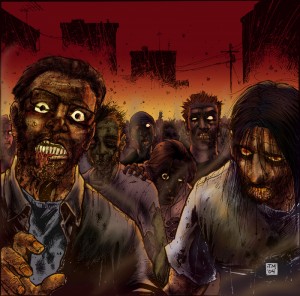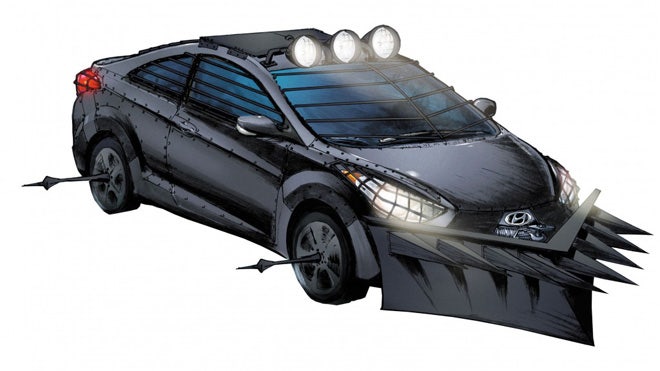Tag Archives: walking dead
ZOMBIE HISTORY – Zombie Scenes in the Bible
Zombies loom large in popular culture these days. Max Brooks’ “World War Z: An Oral  History of the Zombie War” (2006), the Jane Austen, Seth Grahame-Smith mashup “Pride and Prejudice and Zombies” (2009), and Melissa Marr’s “Graveminder” (2011), to name but a few recent novels, enjoy a wide readership. There are also graphic novels, the AMC television show “The Walking Dead,” video games, and of course movies. Some of my recent favorites in the latter category include the Norwegian Nazis-as-zombies film “Dead Snow” (2009) with its delightful tagline “Ein! Zwei! Die!” and Drew Goddard and Joss Whedon’s “The Cabin in the Woods” (2012). With all of this going on, there is little surprise to come across the open-source, collaborative Stinque Zombie Bible. It was just a matter of time, I suppose, and the King James Bible will never be quite the same.
History of the Zombie War” (2006), the Jane Austen, Seth Grahame-Smith mashup “Pride and Prejudice and Zombies” (2009), and Melissa Marr’s “Graveminder” (2011), to name but a few recent novels, enjoy a wide readership. There are also graphic novels, the AMC television show “The Walking Dead,” video games, and of course movies. Some of my recent favorites in the latter category include the Norwegian Nazis-as-zombies film “Dead Snow” (2009) with its delightful tagline “Ein! Zwei! Die!” and Drew Goddard and Joss Whedon’s “The Cabin in the Woods” (2012). With all of this going on, there is little surprise to come across the open-source, collaborative Stinque Zombie Bible. It was just a matter of time, I suppose, and the King James Bible will never be quite the same.
I am an unabashed zombie fan but also teach “classic” English literature and the New Testament so I can’t quite bring myself to desecrate the literary and religious masterpiece that is the Authorized (King James) Version by contributing to the Zombie Bible. Still, wanting to get into the spirit of things, I can’t resist noting a few biblical scenes and themes — a top 10 list — that come to mind each time I watch or read the latest version of the zombie apocalypse to come along. At least in some passages, a zombie-Bible mashup requires very little editorial interference.
1. The Gospel of Luke: “Why do you look for the living among the dead? He is not here, but has risen” (Luke 24:5). Such a suggestive phrase. Note also that the angels asking the question and those they address are standing inside a tomb at the time (Luke 24:2-4).
2. The Book of Revelation: “the sea gave up the dead that were in it” (Revelation 20:13). John the Seer’s creepy statement reminds me of a scene in George A. Romero’s “Land of the Dead” (2005) that features slow-moving corpses walking out of the surf, and Max Brooks’ “World War Z” with its account of the boy returning from a swim with a bite mark on his foot. He also describes the zombie hoards roaming the world’s oceans: “They say there are still somewhere between twenty and thirty million of them, still washing up on beaches, or getting snagged in fisherman’s nets.”
3. Deuteronomy: “Your corpses shall be food for every bird of the air and animal of the earth, and there shall be no one to frighten them away” (Deuteronomy 28:25-26; cf. 2 Samuel 21:10; Psalm 79:1-2; Isaiah 34:2-3; Jeremiah 7:33). The ancients worried about the exposure of their body after death. Improper care of one’s corpse was a terrifying prospect, so it is no wonder it features in prophetic warnings of divine wrath. Qoheleth insists that even though a man lives a long life and has many children, if he “has no burial … a stillborn child is better off than he” (Ecclesiastes 6:3). The indignity of non-burial presumably accounts for the honor bestowed on the poor man Lazarus in Jesus’ parable; the rich man receives proper burial but Lazarus “was carried away by the angels to be with Abraham” (Luke 16:22) because there was no one to care for his remains.
4. The Book of Job: “Why is light given to one in misery, and life to the bitter in soul, who long for death, but it does not come, and dig for it more than for hidden treasures…?” (Job 3:20-21). Job is angry he did not die at birth (3:11), adding that he loathes his life and does not want to live forever (7:16). Others prefer death to life out of principled anger against God, like the prophet Jonah (4:3; cf. 4:8). Physical death eludes a surprising number of people in the Christian Bible, and this is not always a welcome thing. The prophet John refers to some who “seek death but will not find it; they will long to die, but death will flee from them” (Revelation 9:6). The prospect of an elusive death, as every zombie fan knows, terrorizes the living. The “stricken” Charlotte Lucas in “Pride and Prejudice and Zombies” agrees to marry the tedious and obsequious minister Mr. Collins because she wants “a husband who will see to [her] proper Christian beheading and burial.” This is no small task for most survivors left with such a grim assignment, as Shaun well knows: “I don’t think I got it in me to shoot my flat mate, my mom, and my girlfriend all in the same evening” (“Shaun of the Dead,” 2004).
5. The Gospel of Matthew: “The tombs also were opened, and many bodies of the saints who had fallen asleep were raised. After [Jesus’] resurrection they came out of the tombs and entered the holy city and appeared to many” (Matthew 27:52-53). Unwanted persistent life is a recurring image in biblical literature and so too is language referring to the impermanence of bodily death. The dead do not stay dead. The psalmist is confident he will not “see decay” (Psalm 16:10 New International Version; cf. Acts 2:27; 13:35). We read of the physical resurrections of specific individuals (e.g., 1 Kings 17:17-24; Luke 8:49-56; maybe Acts 20:7-12) and expected mass revivals (e.g., 1 Thessalonians 4:16-17). Some of these accounts of un-dying involve reference to un-burying. Mary and Martha’s brother Lazarus walks out of his tomb when “they took away the stone” (John 11:41). On Easter morning, mourners find “the stone, which was very large, had already been rolled back” (Mark 16:4). A second century writer describes further the events preceding Jesus’ emergence from the tomb: “That stone which had been laid against the entrance to the sepulchre started of itself to roll and gave way to the side, and the sepulchre was opened” (Gospel of Peter9.35).
6. Ezekiel: Ezekiel receives a vision promising the restoration of Israel (37:11). Seeing a valley full of bones, the Lord instructs him to speak to them, saying, “O dry bones … I will cause breath to enter you, and you shall live. I will lay sinews on you, and will cause flesh to come upon you, and cover you with skin, and put breath in you, and you shall live” (37:4-6). When Ezekiel does so, “there was a noise, a rattling” as bones come together and sinew and skin appears and the breath of life returns. The dry bones “lived, and stood on their feet, a vast multitude” (37:7-10).
7. Zechariah: “their flesh shall rot while they are still on their feet; their eyes shall rot in their sockets, and their tongues shall rot in their mouths” (Zechariah 14:12). They seem to resemble extras in a George A. Romero film.
8. The Gospel of Mark: “hell, where their worm never dies” (Mark 9:48; alluding here to Isaiah 66:24). Gehenna (here symbolically representing “hell,” and usually translated so, as in Mark 9:44, 45, 47) refers to the Valley of Hinnom located to the south and southwest of Jerusalem. Following the reign of Israel’s righteous King Josiah (see 2 Kings 23:10-14), it became Jerusalem’s garbage heap, a place with maggots and rotting corpses. Jesus refers to this burning garbage in Mark 9:48, a place where residents of the city would leave the rotting corpses of humans and animals to the worms that do not die, to maggots. The image suggests the corpses of the damned rot ingehenna/hell — maggot ridden — in perpetuity.
9. 2 Maccabees: “[Antiochus IV Epiphanes] was seized with a pain in his bowels, for which there was no relief, and with sharp internal tortures — and that very justly, for he had tortured the bowels of others with many and strange inflictions … he fell out of his chariot as it was rushing along, and the fall was so hard as to torture every limb of his body. … the ungodly man’s body swarmed with worms, and while he was still living in anguish and pain, his flesh rotted away, and because of the stench the whole army felt revulsion at his decay. Because of his intolerable stench no one was able to carry the man who a little while before had thought that he could touch the stars of heaven” (2 Maccabees 9:5-6, 7, 9-10). The Syrian ruler’s physical body rots away zombie-like while he still lives. The cause is divine, as the God of Israel strikes this enemy of the Jews with “an incurable and invisible blow” (2 Maccabees 9:5).
10. Genesis with the Book of Revelation: “the earth was a formless void and darkness covered the face of the deep”; “the first heaven and the first earth has passed away, and the sea was no more” (Genesis 1:2; Revelation 21:1). With the disappearance of chaos, Eden returns: “On either side of the river is the tree of life with its twelve kinds of fruit” (Revelation 22:2; cf. Genesis 2:9). Horrors stories often wander back and forth between forms of paradise (ordered society) and chaos (some variant of an apocalyptic hellscape) thus recalling biblical stories with similar alternations. Zombie stories typically depict the disintegration of the modern world, and often hint at a return from the wilderness to the paradisiacal garden for survivors (cf. Genesis 3:23-24). Danny Boyle’s “28 Days Later” (2002), for one, ends with a developing romance between Jim and Salina, happy in the cultivated lands around a cottage that echoes Adam and Eve in the Garden of Eden. The sequel “28 Weeks Later” (2007), however, depicts a failed attempt to restore Eden. After the spread of the disastrous infection in the first film, the sequel documents efforts to repopulate the United Kingdom. Survivors return to their homeland, to what the director’s commentary refers to as “a new world” and a “Garden of Eden.” Naturally, mayhem ensues and the infection spreads as the movie unfolds. It wouldn’t be much of a horror movie otherwise.
ZOMBIE OUTBREAK – PLAN FOR SURVIVAL
“They’re coming to get you, Barbara.” Ever since George Romero’s 1968 classic “Night of the Living Dead,” America has been obsessed with zombies. But some days the zombie apocalypse doesn’t feel so far-fetched. Before you go boarding up your windows, loading your shotgun and stampeding to the nearest cellar, finalize your survival plan. After all, the directo of the Centers for Disease Control and Prevention, Ali Khan, noted in his “Zombie Preparedness” article, “If you are generally well-equipped to deal with a zombie apocalypse, you will be prepared for a hurricane, pandemic, earthquake or terrorist attack.” Oh, joy!
• Somebody has poisoned the water hole: Any viewer of AMC’s “The Walking Dead” knows all too well what happens when a “swimmer” gets into the water supply. The U.S. Geological Survey estimates that the average human can last about a week without water, so make sure to stockpile it before it gets contaminated.
You’ll need about a gallon of water per person per day. The six-gallon Reliance Desert Patrol container ($19.99) is durable and easy to carry. Fill up enough of them so that your water supply lasts several days.
Once you’re forced to abandon your shelter — and you most definitely will be — you’re going to need the Katadyn Pocket Water Microfilter ($295.90). Sold on Amazon, this filter is one of the best in the market for decontaminating outdoor water found in streams, rivers or puddles. The price is hefty, but the cost of drinking zombie guts is higher. .
• Don’t wind up on the menu: As long as you have water, you can survive 30 to 40 days without food. However, after a few days, your body and brain will go weak. In a stressful situation like a zombie assault, a sharp mind and healthy body are vital.
If MREs are good enough for battlefield combat, they’re (hopefully) good enough for zombie warfare. Load up on MREs (Meals Ready-to-Eat) ($94.99 for a 12-pack) from Nitro-Pak. If your mouth’s not watering yet, feast your eyes on the canned chicken, beef, pork and turkey ($55.99 for four 28-ounce cans) from Canned Chicken By Survival Cave Food. Mmm, almost as good as fresh brains!
• Dress to kill: You’re going to need some heavy-duty clothing — preferably something that can withstand a life-threatening bite. Zombie expert and author of “Zombie CSU” Jonathan Maberry suggests body armor made from carpet because it’s hard to chew through and can be found practically anywhere.
The Tru-Spec BDU Trouser ($32.90) and Tru-Spec TRU Combat Shirt
($58.90) from AMFO provide tear-resistant, moisture-wicking skin coverage. Bonus: The garments will also allow you to blend in with those corrupt military personnel that always seem to weasel their way into zombie cinema.
For footwear, get something lightweight, durable and waterproof. The Converse 8877 Waterproof SideZip Tactical Boot ($99.99) is perfect. It even has arch support and heel cushions to supply comfort during those long treks through the city and wilderness.
• My personal weapon of choice is a machete for one simple reason: It doesn’t require reloading. The Condor Tool and Knife 14-Inch Golok Machete ($26.95) from KnifeCenter.com has a solid handle and razor-sharp edge perfect for sending heads a-flying.
• Always remember: Safety first! You’ll need to be able to patch up just about any injury on the go. The 299-piece All-Purpose First Aid Kit ($18.49) from Utility Safeguard includes everything from alcohol cleansing pads and aspirin to an emergency blanket and gauze dressing. The only thing this one-stop kit doesn’t offer is a cure for a zombie bite.
If you aren’t familiar with Max Brooks’ “The Zombie Survival Guide: Complete Protection From the Living Dead” ($10.98), buy it at Barnes & Noble ASAP. The book covers everything from zombie physiology and defense tactics to how to prepare your home for a siege.
Another must-read is Roger Ma’s “The Zombie Combat Manual: A Guide to Fighting the Living Dead” ($13.98). It’ll coach you on how to emerge victorious from a close hand-to-hand battle with a living corpse.
Play video games while you still can. Get an Xbox 360 and buy “Left 4 Dead 2″ ($34.99) at GameStop. It lets you take on the infected with objects like a frying pan, ax, chainsaw and baseball bat. Grab some friends and play in multiplayer mode. Now you’ll know who is skilled with melee weapons. Start saying your goodbyes to the friends who aren’t.
ZOMBIE OUTBREAK – Woman Tries To Eat Cop
Zombies aren’t real, (or are they)  of course, unless you live in the world of “The Walking Dead”, and even then they’re not called zombies. But “Walker Apocalypse” just doesn’t have the same ring to it. Of course, with all the stories pouring in from around the nation involving bath salts and their pesky, flesh-eating affect on the human brain–9, at last count–it might be prudent to call this the “Bath Salt Apocalypse”, as The Village Voice suggests.
of course, unless you live in the world of “The Walking Dead”, and even then they’re not called zombies. But “Walker Apocalypse” just doesn’t have the same ring to it. Of course, with all the stories pouring in from around the nation involving bath salts and their pesky, flesh-eating affect on the human brain–9, at last count–it might be prudent to call this the “Bath Salt Apocalypse”, as The Village Voice suggests.
Whatever you call it, it’s pretty damn scary. And, I hate to do this to you, but here’s one more story to add to the growing pile.
A Utica, New York police officer responded to a call about a disturbed person at a bar on Saturday night. When he arrived, he found a 41-year old woman sitting in a stairwell with a blank look on her face. When he tried to engage her in conversation, she became agitated and violent and tried to bite him repeatedly, yelling that she wanted to “eat and kill someone”. She was later taken to the hospital, where it was determined that bath salts were indeed the culprit for her insane behavior.
According to their official Facebook page, Utica officers also responded to two different bath salts calls in one day on June 21st; one regarding a man who claimed to be having bath salt withdrawals and chest pains, and the other involving a woman who was taken to the hospital after experiencing “hallucinogenic effects” from the drug. And while most agree that the synthetic drug causes more of a psychosis than hallucinations, it can lead the user to have very realistic visions that are compared to those that come with taking LSD.
With all the stories coming in about the drug’s effects, it’s sort of surprising that people are continuing to use it. Every drug has its share of dangerous side effects, and some can be fatal, but face-eating? Murderous intent? That’s a side effect I believe I’d want to stay away from, even if I enjoyed partaking.
